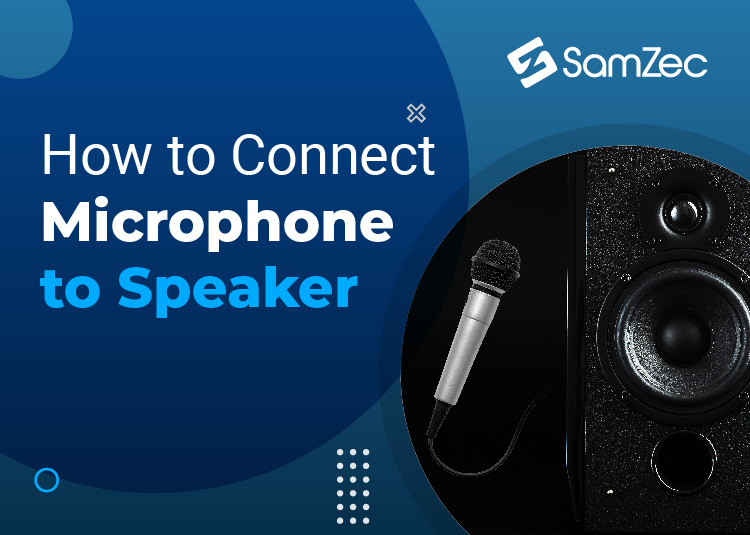So you have bought a microphone and a speaker and you want to amplify your melodious voice. But don’t know how to connect the microphone to the speaker? Well, you can connect your mic directly to the speaker but some conditions need to be fulfilled. For example, your speaker must be self-powered to amplify the sound signals it receives from the microphone. It should also be compatible with the microphone. Meaning that if the microphone has an XLR connector, the speaker should also have an XLR jack. Speakers that need external power (electric) cannot amplify sound directly received from a microphone. Because the signals a mic sends are weaker for the job.
In this blog, we answer your questions related to connecting a microphone to a speaker. By the end of this article, you will also be able to connect your mic to a speaker. So without further ado, let’s get right into it.
Understanding Microphone Connectors
Microphones come with different types of connectors. A connector is a pin that connects with the speaker or with the audio mixer. Although there are many types of microphone connectors, the most common ones are XLR, Mini XLR, TS, TRS, and TRRS. Connectors other than the aforementioned ones are used for more professional and specific purposes.
The XLR connector is perhaps the most commonly used one. It is used with professional equipment as well as with relatively non-professional equipment. The importance of any microphone connector, not just this one, is that it determines whether you will be able to connect it to your speaker or not.
If you are yet to buy the speaker or the microphone, be sure to buy them with the right connectors.
Connecting Microphone Directly to Speaker
Connecting your microphone directly to a speaker means that you are not using any audio console or mixer in between the speaker and the mic. Essentially, you are directly connecting the mic to the speaker. This method can work if the speaker does not need external electric power to function. Recently produced speakers, particularly the ones that come with a battery and a store charge are self-powered.
Technically, these speakers also have audio consoles in them but it is much different than the professional audio consoles.
Connecting the microphone to these speakers is effortless. Simply insert the microphone connector into the dedicated jack on the speaker. Turn on the speaker and the mic, and start speaking or singing for that matter.
Just like that, you have connected your mic to the speaker. You can adjust the volume by toggling the buttons and gauges on the speaker. Pertinent to mention here is the fact that these kinds of speakers do not have fancy sound control options. At best, you can amp up or down the eco or filter out minor noise. And for professional use, these are not speakers.
How to Connect a Wireless Mic and a Speaker Directly?
If you have one of those Bluetooth-powered speakers and microphone setups, you can connect them by simply turning their power on.
Upon turning their switches on, they should connect automatically. And once they connect, you will hear a sound from the speaker confirming the connection. If for some reason the microphone does not connect to its audio receiver, you will need to check whether the mic has battery power. If so, check the power connection of the receiver. If it still does not work, have it checked by an expert because it is a rather complex task.
How to Connect Microphone to Speaker
If you have an external powered speaker and want to connect it with a microphone, here’s how to do it: First of all, place the speaker where you want it to be. Be sure to stretch out the entire cable and do not keep the coiled cable in between. This will enhance the sound quality to a considerable extent.
Then connect one end of the audio cable to the speaker and the other end to the audio mixer. Also, connect the microphone cord to one of the ports on the mixer. Now, connect the power cables of the speaker and the mixer. If your microphone is wireless, you will need to connect the receiver of the mic to the mixer. The receiver will then transmit the signals to the audio mixer.
Cons of Directly Connecting a Microphone to a Speaker
Well, you would think that it is much more convenient and affordable to have a sound system when you can connect the mic and the speaker directly, without a mixer. It is indeed affordable and convenient but it comes with its downsides.
The biggest problem is the quality of sound. You will not get a crisp sound with a cheap system. The decibel levels are also limited and sound is amplified only to a limited level.
Another major problem with directly connecting a speaker to a microphone is the noise. You cannot filter out most of the annoying noise when there is no mixer in between to mediate.
Conclusion
In short, connecting a microphone to a speaker via a mixer is ideal. But for recreational and temporary purposes, you can also connect a speaker to a microphone if the former is self-powered. We hope this blog was of help and you are now able to connect your mic to a speaker.
FAQs
1. Can I connect a microphone directly to any speaker?
No, you can only connect a microphone to a speaker if the speaker is self-powered. You can tell it is not self-powered if it has a fan to cool it down or a power plug.
2. Is it better to connect a microphone directly to a speaker or via a mixer?
Connecting a mic to a speaker via a sound mixer is much better. You will have much more control over the quality of sound.
3. How can I boost my speaker’s sound level?
You can boost the sound level of a speaker by using an amplifier. Amplifiers essentially use electric power to level up the sound coming from the microphone.




















